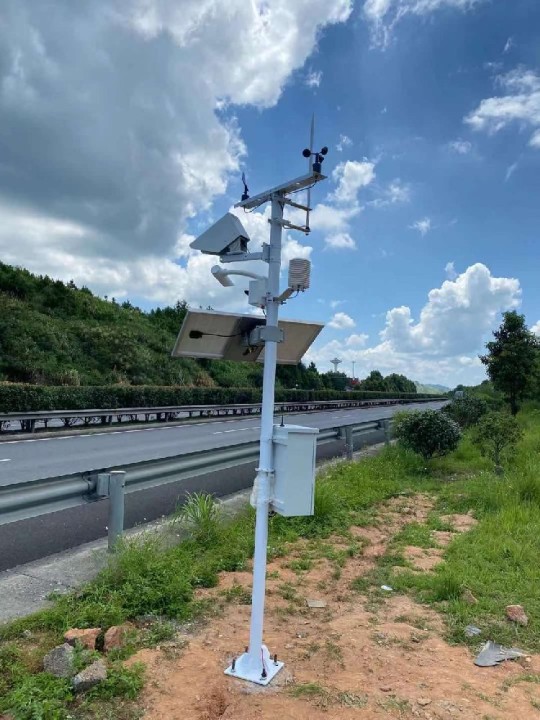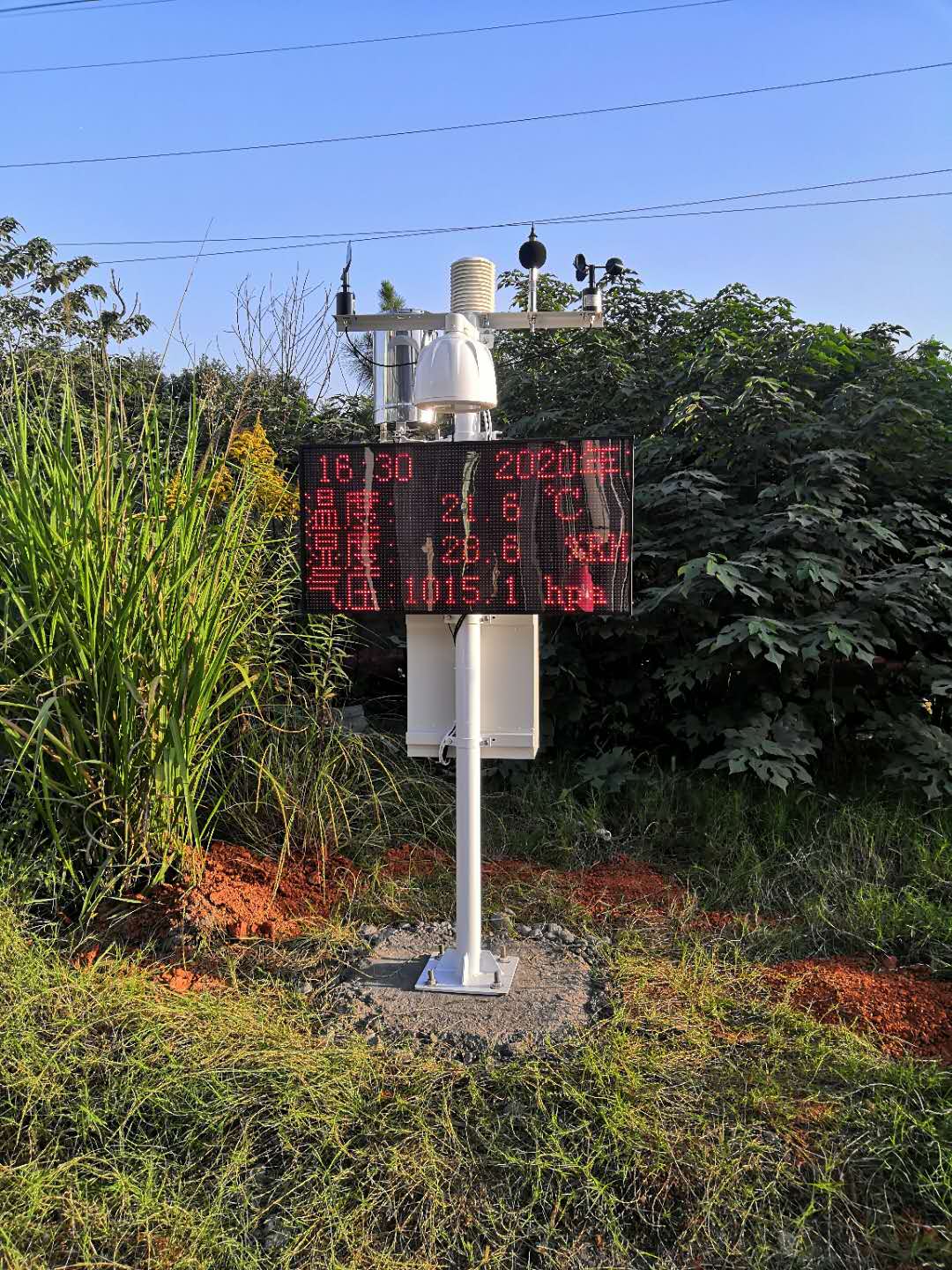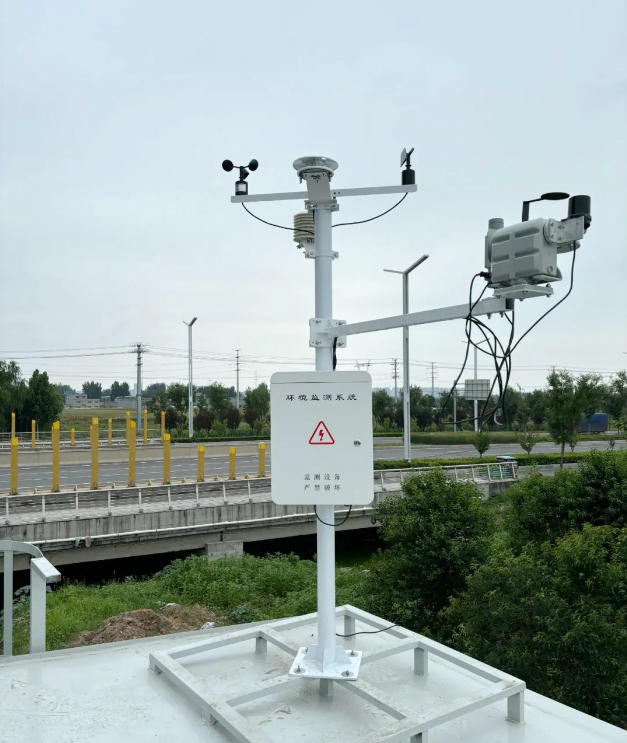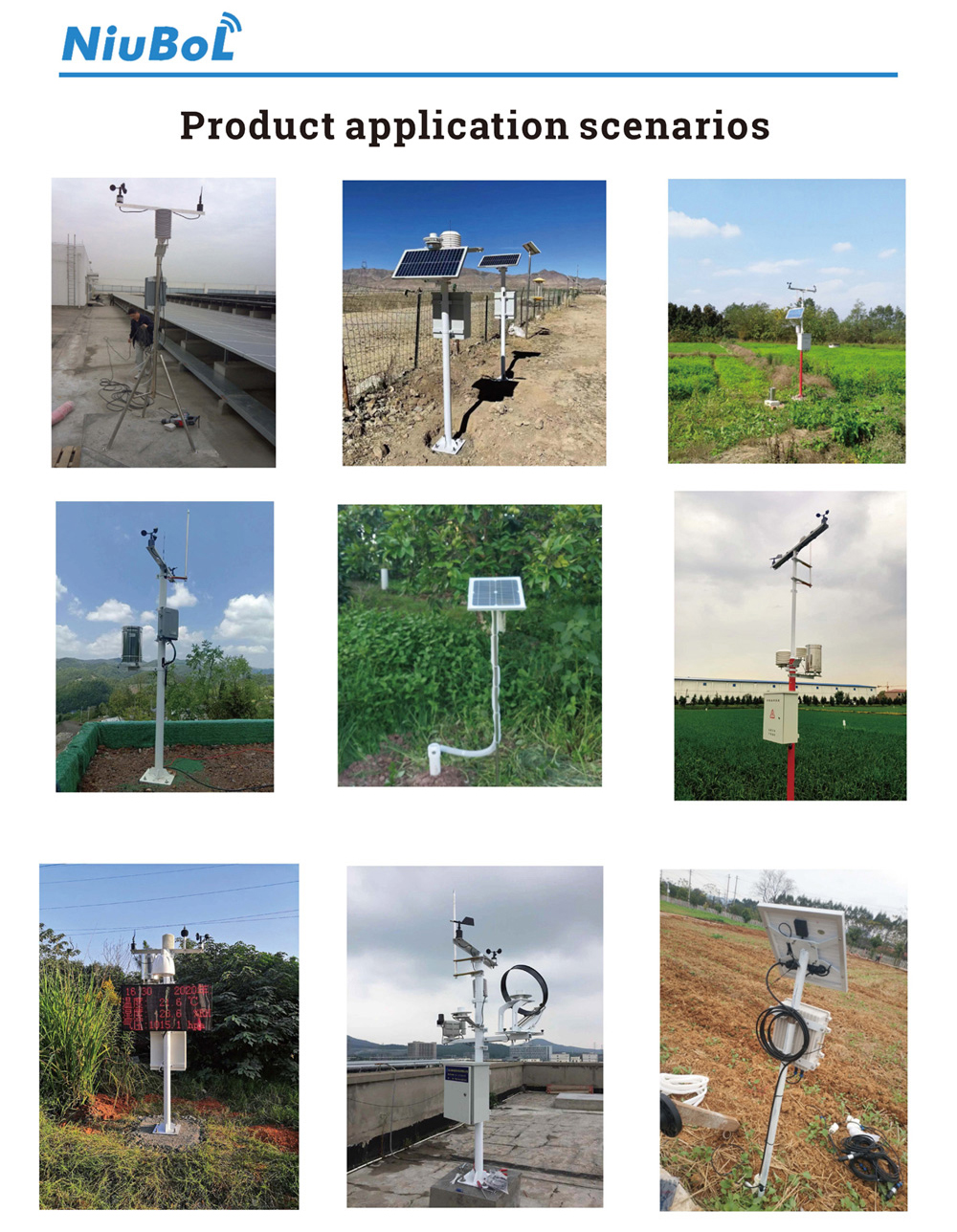

— Products —
 Consumer hotline +8618073152920
Consumer hotline +8618073152920 WhatsApp:+8615367865107
Address:Room 102, District D, Houhu Industrial Park, Yuelu District, Changsha City, Hunan Province, China
All products
road weather station consists of a number of automatic weather stations networked together on key road sections such as highways, mountain roads, bridges and tunnels. These automatic weather stations use comprehensive collection and control technology, computer software technology, communication technology and other advanced technologies, a variety of meteorological sensors for the integrated application. These sensors are capable of real-time monitoring of various meteorolog···
Tel/WhatsApp:+8615367865107
Email:Arvin@niubol.com +Nearly 100 partner companies in more than 68 countries. We are committed to providing high-quality, practical products to meet your needs and help you solve problems. Our products comply with international standards and are certified with ISO, CE and RoHS.Product Details
As an important meteorological observation equipment, road weather station is playing an increasingly important role in modern transportation system. It is designed for road traffic service, and can monitor multiple weather elements along the road in real time, providing accurate weather information for traffic management departments and drivers, thus supporting traffic safety management and decision-making. In this paper, we will introduce the working principle, functions, application scenarios and the importance of road weather station in ensuring road safety from various aspects.
Road weather station is a kind of meteorological monitoring system designed for road traffic, which uses advanced sensor technology and Internet of Things (IoT) technology to monitor and analyze the meteorological conditions along the road in real time. Its core components include:
1. Sensors: used to collect meteorological data and road condition data, such as temperature sensors, humidity sensors, wind speed sensors, wind direction sensors, rainfall sensors, visibility sensors, and road condition sensors.
2. Data Collector: Preliminary processing and storage of data collected by sensors and preparation for transmission.
3. communication equipment: real-time transmission of collected data to traffic management center or cloud platform, usually using wired or wireless communication (4G/5G).
4. display and alarm system: set up displays at the traffic management center or roadside to display real-time meteorological and road surface information and issue early warnings under adverse weather conditions.
5. Power supply system: Provide stable power supply for the weather station, which may include solar panels, batteries, etc.
6. Riser and mounting structure: support all equipment to ensure stability and weather resistance.
The road weather station consists of a number of automatic weather stations networked together on key road sections such as highways, mountain roads, bridges and tunnels. These automatic weather stations use comprehensive collection and control technology, computer software technology, communication technology and other advanced technologies, a variety of meteorological sensors for the integrated application. These sensors are capable of real-time monitoring of various meteorological parameters in the environment, such as wind speed, wind direction, temperature, humidity, visibility, rainfall and road surface conditions (e.g., road surface temperature, wet and dry conditions, snow, etc.).
Road weather stations are capable of monitoring a wide range of meteorological elements, which are essential for ensuring road traffic safety. The following are some of the main meteorological elements monitored by road weather stations:
Road weather stations monitor temperatures in real time, recording them in degrees Celsius. Changes in temperature have a significant impact on aspects such as road freezing, snow melting and driver comfort. Higher temperatures may cause the road surface to heat up, increasing the friction between the tires and the road surface, while lower temperatures may lead to icing and road sliding, increasing the risk of driving.
Humidity reflects the amount of water vapor in the air and is usually expressed as a percentage of relative humidity. High humidity conditions tend to make road surfaces wet, reducing the friction between tires and road surfaces and increasing the risk of vehicle skidding. At the same time, high humidity may also lead to the formation of fog, reducing visibility and affecting driving safety.
Barometric pressure is the force of atmospheric pressure per unit area, usually recorded in pascals or hectopascals. Changes in barometric pressure can predict weather trends, such as a drop in barometric pressure usually means that precipitation or severe weather may be on the way. For highway traffic, keeping abreast of changes in barometric pressure can help prepare for them in advance.
Wind speed is a physical measure of the speed of the wind, usually recorded in meters per second (m/s) or kilometers per hour (km/h). Strong winds can create lateral forces on a moving vehicle and affect its stability, especially in open areas such as bridges and mountain passes.
Wind direction refers to the direction in which the wind is blowing, and is usually expressed in terms of geographic location (e.g., north, southeast, etc.) or degrees (°). Wind direction works in conjunction with wind speed to determine the direction in which the wind affects the vehicle. Knowing the wind direction can help drivers adjust the direction of travel in advance, reducing wind resistance and improving driving stability.
Precipitation is the total amount of rain, snow, hail, etc. that falls to the ground in a given period of time, usually recorded in millimeters (mm). Precipitation includes rain, snow, hail and other forms, of which rainfall will make the road surface slippery, reduce the friction between the tires and the road surface, and increase the braking distance; snowfall and hail may lead to ice on the road surface, affecting driving safety.
Road surface conditions include whether the road surface is dry, wet, waterlogged or icy. Road weather stations can reflect real-time road surface conditions by monitoring the road surface temperature, degree of wetness, etc., providing drivers with accurate road information and helping them take appropriate driving measures to ensure driving safety.
Visibility refers to the distance of the farthest target object that an observer can see in the atmosphere. Low visibility affects the driver's line of sight and increases the chance of traffic accidents. In foggy weather, visibility may drop to tens of meters or even a few meters, making it difficult for drivers to see the road and vehicles in front of them, making it easy for accidents such as tailgating to occur. Road weather station through the visibility sensor real-time monitoring of visibility changes, to provide timely data support for the traffic management department, to help issue speed limits or road closure notice to prevent traffic accidents.
In summary, the meteorological elements that can be monitored by the road weather station cover temperature, humidity, air pressure, wind speed and direction, precipitation, road surface condition and visibility, etc., which are of great significance to ensure road traffic safety. Through real-time monitoring and analysis of the changes in these elements, the road weather station can provide accurate meteorological information for traffic management departments and drivers to support traffic safety management and decision-making.

1. Real-time monitoring: the road weather station can monitor the meteorological conditions along the road such as visibility, wind speed, wind direction, air temperature, humidity, road surface temperature and humidity 24 hours a day to ensure the real-time and accuracy of the data. This helps the traffic management department to understand the meteorological conditions of the road in time and take corresponding traffic control measures.
2. Multi-factor monitoring: In addition to conventional meteorological factors (wind, temperature, humidity, rain, pressure), the road weather station can also monitor visibility, road surface conditions and other key information, providing comprehensive meteorological information for the traffic management department.
3. Remote management: through 4G, Ethernet and other wireless transmission technologies, the road weather station can transmit the real-time monitored weather data to the data center of the traffic management department without on-site personnel, which is convenient for the management department to analyze and make decisions.
4. Early warning and forecasting: Based on real-time weather data, the road weather station can carry out road weather early warning and forecasting to remind drivers and passengers to pay attention to driving safety.
5. Intelligent decision-making support: Combining historical data and weather forecasts, it provides intelligent decision-making support for traffic management, such as adjusting speed limits and closing dangerous roads.
6. Road condition assessment: Pay special attention to the road condition, such as detecting icing, snow thickness and slippery degree, to ensure the safety of vehicle traveling.
7. Environmental adaptability: Adapt to various climate conditions, ensure stable operation and provide reliable information even in extreme weather.
8. Over-limit Alarm: Setting thresholds, automatic alarm and quick response when weather elements exceed the safe range.
9. Multi-terminal access: Data can be viewed in different terminals such as computer, cell phone, etc., facilitating immediate response.
10. Historical data analysis: Store and provide historical meteorological data for research and future planning.
11. Visibility monitoring: Measurement of atmospheric visibility, especially in adverse weather conditions such as fog, rain and snow.
These functions work together to ensure that road traffic can operate safely and efficiently in all weather conditions, and are an indispensable part of modern traffic management.

Highway: highway is one of the important application scenarios of road weather station. Setting up weather stations along the highway can monitor the meteorological conditions of the road in real time, providing timely and accurate weather information for the traffic management department to ensure the smooth flow of the highway and traffic safety.
Mountainous roads: Mountainous roads are more easily affected by meteorological conditions due to their complex terrain and changing climate. Setting up meteorological stations in these roads can obtain timely meteorological data in mountainous areas, provide drivers with accurate meteorological warnings, and reduce driving risks.
Bridges and tunnels: Bridges and tunnels and other special road sections are more likely to be affected by meteorological conditions due to their complex structure and restricted vision. Setting up meteorological stations in these sections can monitor the meteorological conditions of the road in real time, provide timely and accurate meteorological information for the traffic management department, and ensure the driving safety of special road sections.

Road weather station as a guarantee of road safety of the wisdom of the eye, has a very high importance and value. It can not only provide real-time weather information to help traffic management departments to take timely traffic control measures, but also provide drivers with accurate weather warnings to reduce the risk of driving. In addition, the data from road weather stations can be used in scientific research, weather forecasting and water resource management, contributing to the sustainable development of society.
1. Traffic safety: reduce traffic accidents caused by bad weather and poor road conditions through real-time monitoring and early warning.
2. Traffic management: Provide decision-making support for traffic management departments, such as road closure, traffic diversion, snow removal operations, etc.
3. Information service: provide real-time road and weather information to drivers to help them make safer driving decisions.
4. Scientific research: collecting meteorological and traffic data for scientific research, such as research on the impact of climate change on traffic.
5. Urban planning: provide data support for urban planning to optimize the layout of transportation networks and infrastructure.
Road weather station is an important part of Intelligent Transportation System (ITS), which is of great significance to improve the safety and efficiency of road transportation.
VI. Future Prospects
With the advancement of technology, future road weather stations will be more intelligent and integrate more advanced functions, such as predicting changes in traffic flow through AI, and seamlessly connecting with self-driving vehicles to provide personalized driving advice. Meanwhile, with the popularization of the Internet of Things, road weather stations will become an important part of the infrastructure of the smart city, working with other intelligent systems to build a safer, more efficient and greener transportation environment.

Conclusion
With the continuous development of science and technology, the function and performance of the road weather station will continue to improve. In the future, it will be more intelligent and networked, providing more comprehensive and accurate meteorological services for road traffic. At the same time, we also need to strengthen the construction and maintenance of road weather stations to ensure that they can operate stably for a long time and escort road safety.
Sensors & Weather Stations Catalog
Agriculture Sensors and Weather Stations Catalog-NiuBoL.pdf
Weather Stations Catalog-NiuBoL.pdf
Related recommendations
 Multi-Depth Soil Sensor RS485
Multi-Depth Soil Sensor RS485 TDR Soil Moisture Sensor
TDR Soil Moisture Sensor Pyranometer Solar Radiation Sensors
Pyranometer Solar Radiation Sensors Soil ph sensor
Soil ph sensor Tipping Bucket Rain Gauge
Tipping Bucket Rain Gauge Air Temperature and Humidity Sensor
Air Temperature and Humidity Sensor
Screenshot, WhatsApp to identify the QR code
WhatsApp number:+8615367865107
(Click on WhatsApp to copy and add friends)
